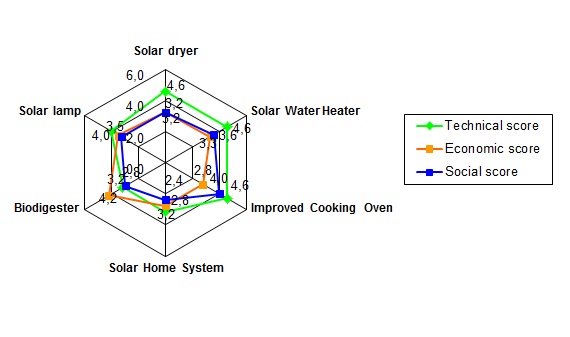Difference between revisions of "The Micro-energy Final Assessment Tool (MEFAT)"
***** (***** | *****) m |
***** (***** | *****) m |
||
| Line 1: | Line 1: | ||
| − | |||
= Overview<br/> = | = Overview<br/> = | ||
| Line 30: | Line 29: | ||
== Structure of the Tool<br/> == | == Structure of the Tool<br/> == | ||
| − | The '''Micro-Energy Final Assessment tool (MEFAT)''' has two levels: The first level consists of the technology profiles and the second level of the multi-criteria assessment. The technology profiles include the description of six selected micro-energy technologies ([[Solar_Drying|solar dryer]], solar water heater, [[Baking_with_Improved_Ovens|improved cooking oven]], [[ | + | The '''Micro-Energy Final Assessment tool (MEFAT)''' has two levels: The first level consists of the technology profiles and the second level of the multi-criteria assessment. The technology profiles include the description of six selected micro-energy technologies ([[Solar_Drying|solar dryer]], solar water heater, [[Baking_with_Improved_Ovens|improved cooking oven]], [[Solar Home Systems (SHS)|solar home system]], [[Types_of_Biogas_Digesters_and_Plants|biodigester]] and solar lamp) and one calculator for each technology. The calculators provide the main technology and project specific technical, economic and social parameters that are needed for the preliminary evaluation of the technology.<br/>In the second level, a multi criteria assessment is applied on the six technologies, considering the parameters calculated in the technology profiles and further non-measurable parameters and criteria. This is enabled through application of the method of Multi-Criteria Analysis. |
<br/> | <br/> | ||
| Line 54: | Line 53: | ||
<references /> | <references /> | ||
| + | [[Category:Energy_Poverty]] | ||
| + | [[Category:Financing_and_Funding]] | ||
| + | [[Category:Impacts_Economic]] | ||
| + | [[Category:Impacts_Health]] | ||
[[Category:Impacts_Social]] | [[Category:Impacts_Social]] | ||
| − | |||
| − | |||
| − | |||
| − | |||
Revision as of 14:20, 15 August 2014
Overview
In the context of this tool small-scale technologies that provide energy to households, small commercial or agricultural enterprises and are possibly financed by a private micro-finance institution (MFI) are characterized as micro-energy technologies and the related systems as micro-energy systems.
Micro-energy Technologies
There is a wide range of micro-energy technologies regarding size, complexity, connection to the demand and used fuel. Furthermore, when planning a micro-energy system, there have to be considered parameters, which vary depending on the local conditions, such as type of households (size, location and energy needs), living conditions of the inhabitants, climate, energy prices, availability of resources etc.
Not only the conditions, but also the goals are variable. Goal can be, depending on the project, a certain energy saving, a CO2 reduction or a cost reduction. The link between conditions and goals takes place through the used technology. Depending on the local conditions and the wanted goals, another technology is suitable in each case.
Another challenge in micro-energy projects is that the considered parameters are not only technical and economic but also social and therefore hard to measure. Social issues are important and must be considered by the selection of the appropriate technology and by the final assessment of the project.There are many questions regarding the social impact of the different micro-energy technologies that also have to be considered by the selection of a technology during energy lending, like:
Does the technology promote job creation? Does it combat poverty? Does it increase health and education conditions? Does it facilitate new businesses? Is the use of the energy product productive or consumptive?
Therefore there is a need of an assessment tool that can consider different aspects (technical, economic and social) and provide calculations and estimations over selected parameters.
The Micro-Energy Final Assessment Tool (MEFAT)
Purpose of the Tool
The Micro-Energy Final Assessment tool (MEFAT) is a tool that can be used by financial institutions, consultants, NGOs and governmental institutions for the comparison of energy relevant projects during project planning or for the assessment of a project after its implementation. The tool is not intended to provide exact predictions of the results of the projects and is not suited for the final sizing of the equipment. As there is a lack of information regarding the exact technology model used in each project and the circumstances under which the equipment will be used, the tool is based on assumptions and average data acquired through market research. For an exact calculation of the sizing, further data acquirement and detailed calculations on the concrete model used in a specific project are required.
Structure of the Tool
The Micro-Energy Final Assessment tool (MEFAT) has two levels: The first level consists of the technology profiles and the second level of the multi-criteria assessment. The technology profiles include the description of six selected micro-energy technologies (solar dryer, solar water heater, improved cooking oven, solar home system, biodigester and solar lamp) and one calculator for each technology. The calculators provide the main technology and project specific technical, economic and social parameters that are needed for the preliminary evaluation of the technology.
In the second level, a multi criteria assessment is applied on the six technologies, considering the parameters calculated in the technology profiles and further non-measurable parameters and criteria. This is enabled through application of the method of Multi-Criteria Analysis.
Output of the Tool
The final output of the tool (MEFAT) is a technical, an economic, a social and a total final score from 1 to 5 for each individual micro-energy technology. The resulted scores are calculated using a performance matrix and ratings for selected criteria. These scores enable the comparison between the different micro-energy technologies and can be also expressed as a matrix or as a radar diagram:
Further Information
References
This article is a summary of the Master Thesis of Anastasia Theodoridou (TU Berlin) with topic "Developement of a tool for the analysis and evaluation of micro-energy technologies based on technical, economic and social input-output parameters" (2012)





















